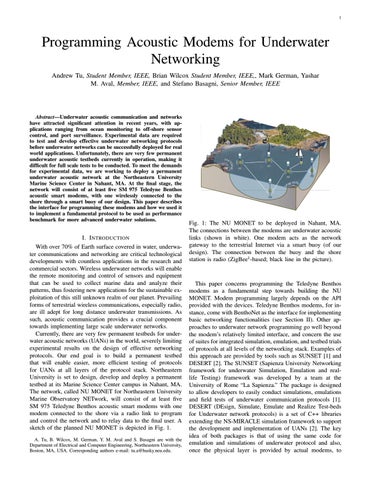1
Programming Acoustic Modems for Underwater Networking Andrew Tu, Student Member, IEEE, Brian Wilcox Student Member, IEEE,, Mark German, Yashar M. Aval, Member, IEEE, and Stefano Basagni, Senior Member, IEEE
Abstract—Underwater acoustic communication and networks have attracted significant attention in recent years, with applications ranging from ocean monitoring to off-shore sensor control, and port surveillance. Experimental data are required to test and develop effective underwater networking protocols before underwater networks can be successfully deployed for real world applications. Unfortunately, there are very few permanent underwater acoustic testbeds currently in operation, making it difficult for full scale tests to be conducted. To meet the demands for experimental data, we are working to deploy a permanent underwater acoustic network at the Northeastern University Marine Science Center in Nahant, MA. At the final stage, the network will consist of at least five SM 975 Teledyne Benthos acoustic smart modems, with one wirelessly connected to the shore through a smart buoy of our design. This paper describes the interface for programming these modems and how we used it to implement a fundamental protocol to be used as performance benchmark for more advanced underwater solutions.
I. I NTRODUCTION With over 70% of Earth surface covered in water, underwater communications and networking are critical technological developments with countless applications in the research and commercial sectors. Wireless underwater networks will enable the remote monitoring and control of sensors and equipment that can be used to collect marine data and analyze their patterns, thus fostering new applications for the sustainable exploitation of this still unknown realm of our planet. Prevailing forms of terrestrial wireless communications, especially radio, are ill adept for long distance underwater transmissions. As such, acoustic communication provides a crucial component towards implementing large scale underwater networks. Currently, there are very few permanent testbeds for underwater acoustic networks (UANs) in the world, severely limiting experimental results on the design of effective networking protocols. Our end goal is to build a permanent testbed that will enable easier, more efficient testing of protocols for UANs at all layers of the protocol stack. Northeastern University is set to design, develop and deploy a permanent testbed at its Marine Science Center campus in Nahant, MA. The network, called NU MONET for Northeastern University Marine Observatory NETwork, will consist of at least five SM 975 Teledyne Benthos acoustic smart modems with one modem connected to the shore via a radio link to program and control the network and to relay data to the final user. A sketch of the planned NU MONET is depicted in Fig. 1. A. Tu, B. Wilcox, M. German, Y. M. Aval and S. Basagni are with the Department of Electrical and Computer Engineering, Northeastern University, Boston, MA, USA. Corresponding authors e-mail: tu.a@husky.neu.edu.
Fig. 1: The NU MONET to be deployed in Nahant, MA. The connections between the modems are underwater acoustic links (shown in white). One modem acts as the network gateway to the terrestrial Internet via a smart buoy (of our design). The connection between the buoy and the shore station is radio (ZigBee1 -based; black line in the picture).
This paper concerns programming the Teledyne Benthos modems as a fundamental step towards building the NU MONET. Modem programming largely depends on the API provided with the devices. Teledyne Benthos modems, for instance, come with BenthoNet as the interface for implementing basic networking functionalities (see Section II). Other approaches to underwater network programming go well beyond the modem’s relatively limited interface, and concern the use of suites for integrated simulation, emulation, and testbed trials of protocols at all levels of the networking stack. Examples of this approach are provided by tools such as SUNSET [1] and DESERT [2]. The SUNSET (Sapienza University Networking framework for underwater Simulation, Emulation and reallife Testing) framework was developed by a team at the University of Rome “La Sapienza.” The package is designed to allow developers to easily conduct simulations, emulations and field tests of underwater communication protocols [1]. DESERT (DEsign, Simulate, Emulate and Realize Test-beds for Underwater network protocols) is a set of C++ libraries extending the NS-MIRACLE simulation framework to support the development and implementation of UANs [2]. The key idea of both packages is that of using the same code for emulation and simulations of underwater protocol and also, once the physical layer is provided by actual modems, to
